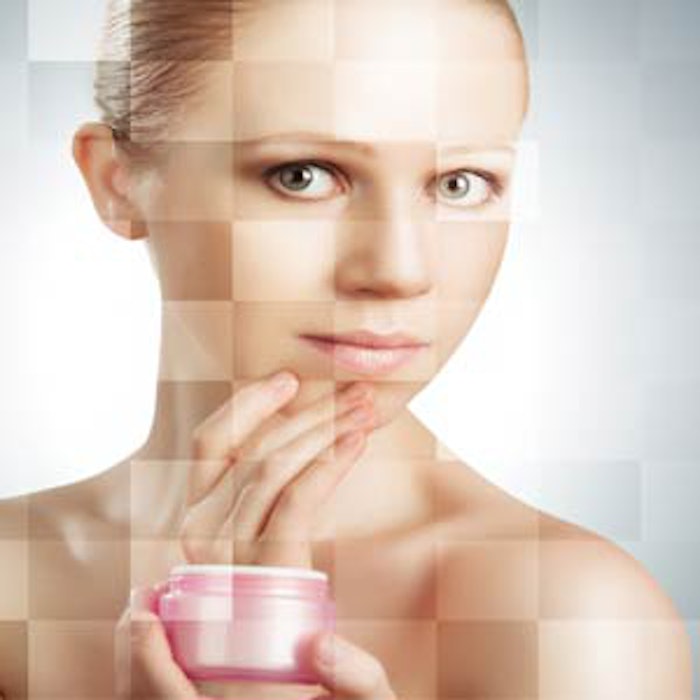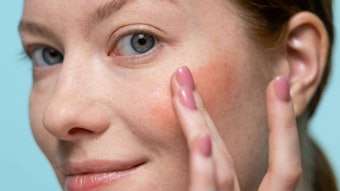
Editor's note: A short-form version of this article appeared in the March 2016 edition of Global Cosmetic Industry magazine.
Retinaldehyde offers a less-irritating, cost-effective and formulation-friendly alternative to a wide array of skin care treatment products. Among the newest topical delivery systems, retinaldehyde γ-cyclodextrin complex (RCC) provides multifunctional opportunities for cosmetics utilizing stabilized retinaldehyde.
Retinaldehyde, in conjunction with complementary treatments including chemical peels, dermabrasion and lasers, can provide a wide-spectrum skin care arsenal to estheticians, dermatologists and in-home use consumers. They offer multifaceted attributes (see Multifaceted Benefits sidebar), described next.1
Retinoids & Retinaldehyde: From Anti-aging to Zits
Anti-acne and skin strength: Retinoids are a group of compounds that impart effects in the body like those of vitamin A, e.g., antioxidant benefits. They have found application in the treatment of both chronological aging and photo-aging,2 and are potent therapeutics, used topically and systemically as anti-acne agents.3 Retinaldehyde also has found application in the treatment of dermatoporosis—a new term proposed to describe the chronic cutaneous insufficiency/fragility syndrome characterized by extreme skin atrophy.4
Antibacterial: Furthermore, retinaldehyde imparts antibacterial benefits. β-Defensins are a family of antimicrobial peptides implicated in the resistance of epithelial surfaces to microbial colonization. In relation, topical retinaldehyde has been found to induce β-defensin-3 expression, thus acting as an antibacterial agent.5
Anti-aging: In addition, retinaldehyde and retinol have been reported to regulate gene expression in keratinocytes to improve the appearance of aged skin. Keratinocyte proliferation and hyaluronan synthesis are believed to be partly mediated through the heparin-binding epidermal growth factor (HB-EGF)-like receptor (EGFR) pathway.6 As such, retinaldehyde has been shown to increase the expression of HB-EGF, as well as the skin's involucrin protein gene (IVL); in both cases, greater than that of retinol.7
Skin discoloration: Lichen sclerosus is an uncommon chronic dermatosis recognized to occur on the anogenital area in perimenopausal women. It appears as small white, shiny, smooth spots on the skin that grow into bigger plaques that become thin and crinkled. In relation, topical retinaldehyde has found application in the treatment of Lichen sclerosus.8 Retinoids also exert skin-depigmenting activity. Unlike most depigmenting agents that target tyrosinase, retinoids are not phenolic agents and may act via different mechanisms.9
Sensitivity Considerations
Topical retinoids have been used to treat rosacea. Retinoic acid, for example, has beneficial effects on the vascular aspect of rosacea. However, while retinoids show promise in the treatment of skin aging, irritant reactions such as burning, scaling or dermatitis associated with some of these therapies can limit their acceptance by patients.2
Retinoic acid treatment has the drawback of a delayed efficacy onset, which can lead to the development of skin dryness, erythema, burning and stinging. A higher tolerance to retinaldehyde vs. retinoic acid has been shown in photo-damaged skin, and with similar efficacy. Therefore, retinaldehyde may be more suited for sensitive, irritated skin conditions such as rosacea and red face syndrome.10 One proposed treatment for rosacea, for example, combines retinaldehyde with the anti-inflammatory agents dextran sulfate and hesperidin methyl chalcone.10
Managing Interactions
To predict the skin's metabolism of retinoids, tools such as MetaSite have been developed. This approach uses a computation to project metabolic transformations related to cytochrome and flavin-containing monooxygenase-mediated reactions, to identify potential skin irritation behavior.11
In addition, as noted, topical retinoic acid precursors such as retinaldehyde or retinol can be used as they are less irritating than acidic retinoids.12 All-trans retinaldehyde is most commonly used. However, retinaldehyde is increasingly rising in the marketplace, possibly due to perceived retinoid-related skin irritations. In response, new topical delivery systems are being developed to circumvent skin irritation-related issues.
Formulating Optimal Delivery
As noted, retinoids are a class of compounds that are chemically related to vitamin A.13 In broader terms, retinoids are any of a group of compounds providing the same biological benefits of vitamin A. The chemical structures of select retinoids and compounds having the biological activity of retinoids are illustrated in Figure 1.
Nanoparticles have shown good potential in improving the stability, tolerability and efficacy of retinoids.14 However, consumer concern over the safety of nanomaterials has made them less favorable.
Other approaches to retinal delivery systems include certain Schiff's bases with polylysine, and retinaldehyde-hyaluronic acid fragments.15 Liposomes of retinaldehyde and other retinoids have been reported for topical applications;16 and a system to deliver retinaldehyde for treating obesity has even been patented.17
Further, various emulsion-based delivery systems for retinaldehyde and other retinoids have been reported18 as well as encapsulated retinaldehyde formulated in a gel-based system for topical applications.19
Combinatorial Therapies
Combinations of retinoids with other agents for greater efficacy and reduced skin irritation is also of renewed interest, especially in dermatological applications. For example, retinaldehyde or tretinoin paired with a skin depigmenting agents has been shown to significantly improve solar lentigines.22
Retinaldehyde, in combination with glycolic acid, also has been reported to treat mild to moderate acne during sun exposure with good skin tolerability.23 Meanwhile, glycylglycine oleamide, a peptide derivative claimed to protect connective tissue from damage caused by glycation and elastosis, has been combined with retinaldehyde to provide a treatment for skin aging.24
Interestingly, it has been found that Epidermal Retinol Dehydrogenase 2 (RDH2) levels are elevated in psoriatic skin. And the potential role of RDH2 in the oxidation of retinol to retinaldehyde for retinoic acid biosynthesis in human keratinocytes has been acknowledged. In relation, 11-cis-retinoic acid, an oxidation product of 11-cis-retinaldehyde, has found application in the treatment of psoriasis.25
Incognito Delivery: Trojan Horse and Carrots
Beyond base formula solutions and ingredient combinations, a novel Trojan-horse delivery system for retinaldehyde, i.e., retinaldehyde γ-cyclodextrin complex (RCC), has been developed to release it in a controlled manner upon topical application.
Gene-expression data indicate RCC offers topical relief from symptoms associated with conditions ranging from melanogenesis and oxidative damage, to inflammation, loss of cell adhesion, skin aging, topical wounds20 and more. RCC and related compounds are prepared by the reaction of a polyene aldehyde, such as retinaldehyde, with a cyclodextrin, such as γ-cyclodextrin.21
How else might retinaldehyde be delivered? Via the human body. The well-known adage that eating carrots (vitamin A) is good for eyesight is also true for the availability of retinaldehyde in human body: β-carotene is converted into retinaldehyde, which is then converted into vitamin A (see Figure 2).26
Conclusions
Retinaldehyde offers a less-irritating, safer, cost-effective and formulation-friendly alternative to retinoic acid for a wider array of skin care products. And to get it where it needs to go, retinaldehyde γ-cyclodextrin complex (RCC) is among the latest delivery systems to provide multifunctional opportunities for cosmetics utilizing stabilized retinaldehyde.
References
- Hubbard et al, Reversal of skin aging with topical retinoids, Plast Reconstr Surg, 133(4) 481e-90e doi: 10.1097/PRS.0000000000000043 (Apr 2014); Rivas et al, Treatment of melasma with topical agents, peels and lasers: An evidence-based review, Am J Clin Dermatol 14(5) 359-76 (Oct 2013) doi: 10.1007/s40257-013-0038-4; Souza et al, Single-session intense pulsed light combined with stable fixed-dose triple combination topical therapy for the treatment of refractory melasma, Dermatol Ther 25(5) 477-80. doi: 10.1111/j.1529-8019.2012.01530.x (Sept/Oct 2012)
- Mukherjee et al, Retinoids in the treatment of skin aging: An overview of clinical efficacy and safety, Clin Interv Aging 1(4) 327-48 (2006); Darlenski et al, Topical retinoids in the management of photodamaged skin: From theory to evidence-based practical approach, Br J Dermatol 163(6) 1157-65. doi: 10.1111/j.1365-2133.2010.09936.x (Dec 2010); Babamiri et al, Cosmeceuticals: The evidence behind the retinoid, Aesthet Surg J 30(1) 74-7. doi: 10.1177/1090820X09360704 (Jan 2010); Ianhez et al, Retinoids for prevention and treatment of actinic keratosis, An Bras Dermatol 88(4) 585-93. doi: 10.1590/abd1806-4841.20131803 (Jul/Aug 2013); Thielitz et al, Topical retinoids in acne, an evidence-based overview, J Dtsch Dermatol Ges 8 Suppl 1:S15-23 (Mar 2010); Baudier, Composition for reducing skin ageing disorders, comprising a retinaldehyde and a leontopodium alpinum extract, WO2015082520 (A1) (Jun 11, 2015); Stratigos et al, The role of topical retinoids in the treatment of photoaging, Drugs 65(8) 1061-72 (2005)
- Dall'oglio et al, Cosmetics for acne: Indications and recommendations for an evidence-based approach, G Ital Dermatol Venereol 150(1) 1-11 (epub Oct 15, 2014; print Feb 2015)
- Kaya, New therapeutic targets in dermatoporosis, J Nutr Health Aging 16(4) 285-8 (Apr 2012); Nikolic et al, Hyalurosome gene regulation and dose-dependent restoration of skin atrophy by retinaldehyde and defined-size hyaluronate fragments in dermatoporosis, Dermatology 229(2) 110-5. doi: 10.1159/000362594 (epub Aug 2014)
- Lee et al, Topical retinoids induce β-defensin 3 expression in mouse skin, Int J Dermatol 49(9) 1082-4 doi: 10.1111/j.1365-4632.2009.04260.x (Sep 2010); Pechère et al, The antibacterial activity of topical retinoids: The case of retinaldehyde, Dermatology 205(2) 153-8 (2002)
- Amann et al, Retinal and retinol are potential regulators of gene expression in the keratinocyte cell line HaCaT, Exp Dermatol 20(4):373-5 doi: 10.1111/j.1600-0625.2010.01127.x (epub Aug 31, 2010; print Apr 2011); Anamm et al, Regulation of gene expression by retinoids, Curr Med Chem 18(9) 1405-12 (2011); Pasonen-Seppänen et al., All-trans retinoic acid-induced hyaluronan production and hyperplasia are partly mediated by EGFR signaling in epidermal keratinocytes, J Invest Dermatol 128 797–807. doi:10.1038/sj.jid.5701098 (epub Oct 18, 2007; print 2008); Harris, EGFR signaling in podocytes at the root of glomerular disease, Nature Medicine 17, 1188–1189 doi:10.1038/nm.2455 (2011)
- Genemarkers LLC, Project Report 024-022 (June 6, 2013)
- Kaya et al, Restored epidermal CD44 expression in lichen sclerosus et atrophicus and clinical improvement with topical application of retinaldehyde, Br J Dermatol 152(3) 570 (Mar 2005); Wakelin et al, Lichen sclerosus in women, Clin Dermatol 15(1) 155-69 (Jan/Feb 1997)
- Sorg et al, The potential depigmenting activity of retinaldehyde, Dermatology 227(3) 231-7 doi: 10.1159/000354294 (epub Sep 24, 2013; print 2013); Kang et al, The role of topical retinoids in the treatment of pigmentary disorders: An evidence-based review, Am J Clin Dermatol 10(4) 251-60 doi: 10.2165/00128071-200910040-00005 (2009); Ortonne, Retinoid therapy of pigmentary disorders, Dermatol Ther 19(5) 280-8 (Sep/Oct 2016)
- Gilbert et al, Efficacy and tolerance of a topical skin care regimen as an adjunct to treatment of facial rosacea, Cosmetic Dermatology 21(9) 501 (Sep 2008)
- Słoczyńska et al., Skin metabolism established with the use of MetaSite for selected retinoids employed in topical and systemic treatment of various skin disorders and found in cosmeceuticals, Acta Biochim Pol 62(2) 201-6 doi: 10.18388/abp.2014_891 (epub Apr 9, 2015; print 2015)
- Sorg et al, Topical retinoids in skin ageing: A focused update with reference to sun-induced epidermal vitamin A deficiency, Dermatology 228(4) 314-25 doi: 10.1159/000360527 (epub May 9, 2014; print 2014)
- https://en.wikipedia.org/wiki/Retinoid (accessed Nov 24, 2015)
- Gao et al, A microparticle/hydrogel combination drug-delivery system for sustained release of retinoids, Invest Ophthalmol Vis Sci 53(10) 6314-23 (Sep 19, 2012)
- Viguera et al, A water-soluble polylysine-retinaldehyde Schiff base. Stability in aqueous and nonaqueous environments, J Biol Chem 265(5) 2527-32 (Feb 15, 1990); Cordero et al, Retinaldehyde/hyaluronic acid fragments: A synergistic association for the management of skin aging, J Cosmet Dermatol 10(2) 110-7 (Jun 2011)
- Gabriel et al, Method for preparing liposomes of retinaldehyde or other precursors of retinoic acid and product thus obtained, WO 2015097317 (A1) (Jul 2, 2015)
- Plutzky et al, Retinaldehyde mimetics and inhibitors of retinaldehyde dehydrogenase in the treatment of disorders, US 2014378530 (A1) (Dec 25, 2014)
- Jenning, Retinoid-containing emulsions with continuous water phase, for topical application, e.g., for skin treatment, repair or renewal, having structured, polar, viscous oil phase to stabilize active agent, DE 19946184 (A1) (Mar 29, 2001)
- Dewandre, New topical composition containing retinaldehyde, EP 0965333 (A2) (Dec 22, 1999); Dihora et al, Delivery particle, US Pat 9,186,642 (Nov 17, 2015)
- Peter et al, Topical therapies based on gene-expression of novel retinaldehyde cyclodextrin complexes, J Dermatolog Clin Res 3(2) 1047 (2015); Peter et al, Retinaldehyde cyclodextrin complex for topical skin therapy, Global Dermatology (2016, submitted for publication)
- Peter et al., U.S. Pat. 8,410,079; 8,859,269.
- Cameli et al, Clinical and instrumental evaluation of the efficacy of a new depigmenting agent containing a combination of a retinoid, a phenolic agent and an antioxidant for the treatment of solar lentigines, Dermatology 230(4) 360-6 doi: 10.1159/000379746 (epub Apr 9, 2015; print 2015); Hexcel et al, Triple combination as adjuvant to cryotherapy in the treatment of solar lentigines: Investigator-blinded, randomized clinical trial, J Eur Acad Dermatol Venereol 29(1) 128-33 doi: 10.1111/jdv.12484 (epub Mar 31, 2014; Jan 2015); Questel et al, Follow-up of solar lentigo depigmentation with a retinaldehyde-based cream by clinical evaluation and calibrated color imaging, Skin Res Technol 21(2) 241-6 doi: 10.1111/srt.12182 (epub Jul 31, 2014; May 2015)
- Masini et al, Combination therapy with retinaldehyde (0.1%) glycolic acid (6%) and efectiose (0.1%) in mild to moderate Acne vulgaris during the period of sun exposure--Efficacy and skin tolerability, Eur Rev Med Pharmacol Sci 18(16) 2283-6 (Aug 2014); Boisnic et al, RALGA (Diacneal) decreases melanin content in a human skin model, Dermatology 210 Suppl 1: 35-8 (2005)
- Agnes et al, Glycylglycine oleamide in dermo-cosmetology, EP1061897 B1; Bacqueville et al, Cosmetic or dermatological compositions combining retinaldehyde and glycylglycine oleamide, and the cosmetic or dermatological uses thereof, WO2014195315 (A1) (Nov 12, 2014)
- Lee et al, Biochemical characterization of human epidermal retinol dehydrogenase 2, Chem Biol Interact 178(1-3) 182-7 doi: 10.1016/j.cbi.2008.09.019 (epub Sep 24, 2008; print Mar 16, 2009); Braiman, Treatment of psoriasis with 11-cis-retinoic acid, WO9634601 (A1) (Nov 7, 1996)
- Shete et al, Mammalian metabolism of β-carotene: Gaps in knowledge, Nutrients 5(12), 4849-4868 doi:10.3390/nu5124849 (2013)










